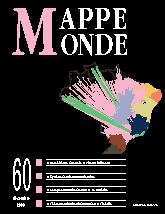

Olivier Pissoat. Homicidal violence in Columbia (2 fig.)
In the 1980s, Colombia saw a return of widespread violence, constantly on the increase. Mapping the homicides per municipality offers a way of analysing this protean phenomenon, aggravated by the drug economy. Between phases of expanding and receding violence, the illusion of its diffusion becomes apparent.
keyword: COLOMBIA, DIFFUSION, DRUGS, VIOLENCE
Patricia Dias. Brazilian cities areas of attraction (6 fig.)
In 1993, the Brazilian Institute of Geography and Statistics (IBGE) conducted a study on the areas of attraction of Brazilian cities. Maps built using those data show clearly that São Paulo is the real national capital and that its area of attraction has grown during the last twenty years, especially in the Amazon region.
keyword: AREAS OF ATTRACTION, BRAZIL, CITIES
Health care and territorial organisation in Burkina Faso (6 fig.)
Until 1995, the health care system in Burkina Faso was based on the principles set forth by the WHO in 1978, particularly the expansion of primary health care. The health map reveals the political influences on the distribution of public health establishments. The low attraction of these dispensaries can be partly attributed to these influences.
keyword: BURKINA FASO, HEALTH CARE,TERRITORIAL ORGANISATION
The bush, space of the Australian myth, or Australias territorial dream (4 fig.)
Australia developed around a vast space considered to be empty. At the same time, the bush has contributed so strongly to the invention of the Australian identity that it has become indissociable from the country's image. The urban population of Australia needed the dream of this territory, but has had to accept necessary changes to its perception.
keyword: AUSTRALIA, AUSTRALIAN IDENTITY, LAND CLAIM, MYTH OF THE «BUSH», NATIONAL TERRITORY
Jean-Luc Morel. Telecommunications in Kathmandu: another opening to the world (4 fig.)
Kathmandu is currently experiencing major socio-economic changes, which are reflected in increased and diversified telecommunications needs. Appropriate solutions can probably be found in the emergence of small businesses, whose distribution reveals the specific character and dynamics of various districts of the city.
keyword: BUSINESSES, KATHMANDU, NEPAL, TELECOMMUNICATIONS, URBAN DYNAMICS
Erwann Jadé. Spatial organisation of the island of Tenerife (6 fig.)
Tenerife, in the Canary Islands, also known as the Fortunate Isles. A fragment of Europe exiled off the coast of Africa, now a leisure ground for the stressed urban dweller. An island with many different faces, whose spatial organisation highlights segregation due to tourism.
keyword: CANARY ISLANDS, SPATIAL STRUCTURES, TENERIFE, TOURISM
Roger Brunet. Nuclear power stations and uranium in the world (7 fig.)
Nuclear energy, produced in 200 places on the planet, currently provides only 20% of the world's electricity. Its share in energy consumption is expected to increase. In contrast, uranium production has concentrated strongly, while awaiting a new boost.
keyword: ELECTRICITY, ENERGY, NUCLEAR, URANIUM, WORLD
Book reviews (Roger Brunet, Morgan Pujol, Pierre Usselmann)
Mappemonde 3/00![]()
![]() Mappemonde 1/01
Mappemonde 1/01
For subscribe or buy this issue: BELIN
Last modified: December 20, 2000